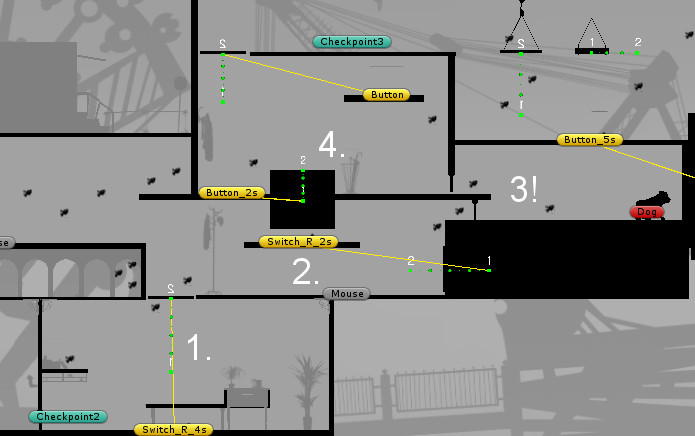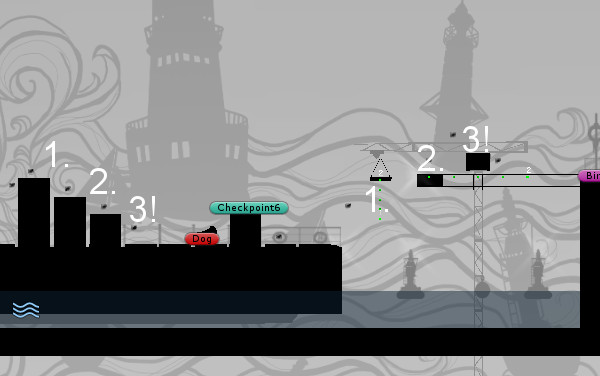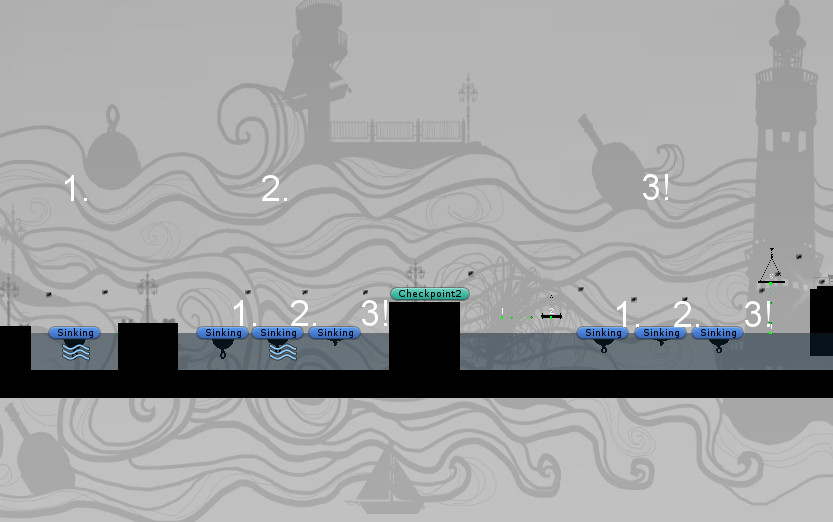The Rule of Three
The Rule of Three states: To break a pattern, you need to have at least three elements.
Origin
The Rule of Three is a writing or comedy principle that describes the most condensed formula for breaking patterns. As such it is not only applicable to writing or comedy, where it originated, but to all forms of entertainment, including games.
(Go to Wikipedia for more background info)
Why break patterns?
Humans try to find patterns in anything around them, to help them make sense of the world. Finding such a pattern, just to be surprised that it was not what they originally expected, is at the heart of most, if not all, entertainment. Forming your expectations, anticipating what happens next and being proven wrong is fun!
How to break patterns
To break a pattern you first need to establish a pattern. For something to form a pattern, it needs to have at least two occurrences of something distinguishably similar. To break it, you add a third that shows a connection to it’s predecessors, but is somehow different.
That’s the rule of three: Three similar elements of which the third one is a diversion from the pattern.
Of course your pattern can be longer than three and, to avoid becoming predictable, you should build in variations. However, three offers the most condensed and effective number here. Keeping to the lowest number of occurrences is also the cheapest thing to do, which can be a good argument if you need to keep an eye on your budget.
Application to Level Design
Now here are some examples of how I applied the Rule of Three in some of the levels I’ve worked on for CatWalk.
![]() Effect Spoilers!
Effect Spoilers!
To experience the effects first hand you might want to give the game a try first (it’s free and short) before these explanations will spoiler and bias your experience. You could even try to look for the use of the rule yourself before I point you to it 😉
The following screenshots have been made from within the editor (Unity3D) to show and highlight the underlying structures.
Three small Platforms, three jumps but the distance gets bigger with each jump, until the cat will only barely make it on the third, having the player instinctively brace himself for impact, adding some tension.
For the first two jumps, the cat will land on it’s feet. The player might notice the second gap being bigger, he most certainly will notice the third. That short moment where he realizes, that this gap was too big. The expected pattern breaking in the his mind, his heart skips a beat, only to have the situation defused by the cat grabbing the edge automatically. Once the cat is hanging from the edge, it can pull itself up and continue on it’s journey.
Notice, this even works if he expects the distance to grow and can actually see it grow, because all other jumps in this and the previous level gave him save distances for his jumps and also had not quite that risky of an abyss to drop into.
(The arrows are all the same size for comparison)
Four rooms and a surprise in the third. Because three puzzles in a row would be boring and expectable.
The rooms are uncovered on entering them. when you unsuspectingly stroll into the third room, you’ll be located around the “3!” with a dog on it’s way to you, before you realized just what you got yourself into. Most players I watched reacted with a momentary panic, jumped or turned around to flee the room. However there was never much of a danger, as the dogs leash prevents it from reaching the cat if it’s not too far in yet.
That effect is also actively increased by not switching to a “room cam” that would expand the player’s view to show the entire room directly. Instead The player has a camera that is zoomed in and a limited field of view
Three containers on a ship, three times dropping to a lower height to catch a fish, but on the last height, a watchdog awaits the player. Additionally this is the third ship, none of the other ships had a dog. They where save. And just when the player comes to trust that ships are save, we convince him of the opposit.
The fish are placed there to keep the player from head on jumping into their demise and instead encourage to “walk of the ledge” to get back to ship-level.
Also, the first two ships the player boards are save, this one appears to be save at first. It has a puzzle and after solving that, still exited about solving it and feeling even saver, he encounters this dog.
Right after that, the player has to navigate three obstacles. The third one is a static block where the moving platform he stands on passes underneath, pushing him off of it.
Interestingly, this only poses a perceived threat to his safety. The initial intension was to have the player jump on the third platform, then back down on the moving one and proceed to the level end. It turned out that our cat would catch on to the ledge of the moving platform if it was pushed over the edge, and then safely travel underneath the obstacle.
Intrigued by the emergence of our own system, we accepted this as an alternative solution and easter egg. I even made room for the cat’s head while it travels past by moving the obstacle up. This leaves the few players that discover it feeling smart and smug as they pass underneath instead of making them think they found a bug 😉
And last but not least, a more complex, nested example:
Three pits of water, the first two introduce sinking platforms, the third one integrates them with existing game-play elements. Where there are three of these, the third consecutive jump from a sinking platform is always a bit more tricky.
In the first case, I choose a distance between the platforms that enabled the player to just jump from one to the next without running forward. However, the cat would always land a bit closer to the left of that next platform whereas for the last jump it needs to bee at the right edge to make it to safety. Additionally, the height and therefore the time until it submerges decreases for each following platform.
In the second case, the player has to reach a moving platform but has more time since the last platform is thicker here.
Conclusion
I hope this could illustrate the concept of the rule of three and why this is such a powerful tool to have knowledge of. Have fun experimenting with it, remember to watch your users’ reactions to it and check if it meets your expectations.
If you have any questions or feedback, want to provide some examples of your own, or learned something you want to share, I’d be happy to hear from you!
And always remember, patterns and rules are to be broken, this one included!




Leave a Comment